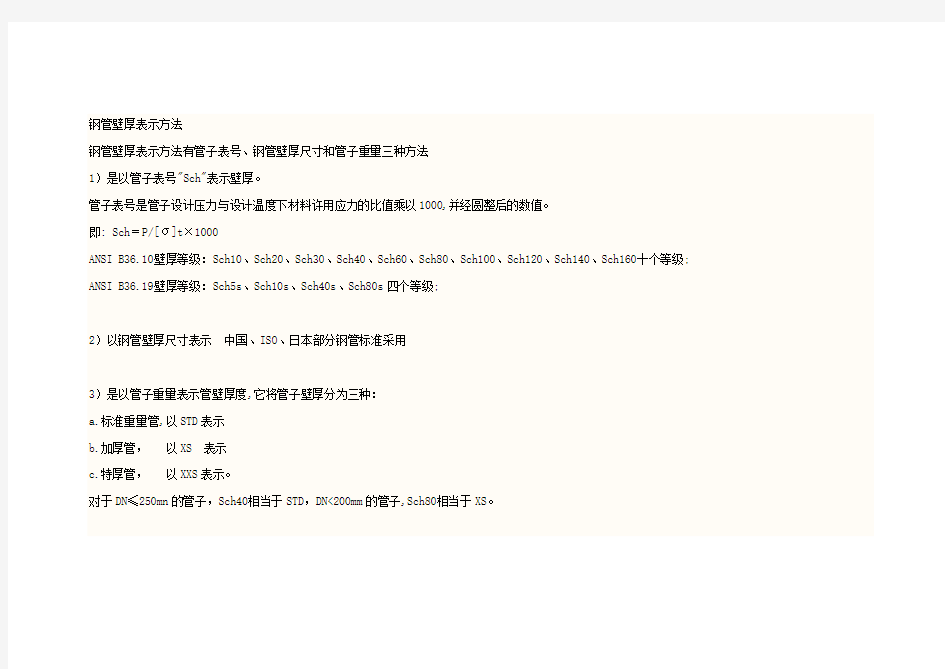钢管壁厚表示方法(Word)

- 1、下载文档前请自行甄别文档内容的完整性,平台不提供额外的编辑、内容补充、找答案等附加服务。
- 2、"仅部分预览"的文档,不可在线预览部分如存在完整性等问题,可反馈申请退款(可完整预览的文档不适用该条件!)。
- 3、如文档侵犯您的权益,请联系客服反馈,我们会尽快为您处理(人工客服工作时间:9:00-18:30)。
钢管壁厚表示方法
钢管壁厚表示方法有管子表号、钢管壁厚尺寸和管子重量三种方法
1)是以管子表号"Sch"表示壁厚。
管子表号是管子设计压力与设计温度下材料许用应力的比值乘以1000,并经圆整后的数值。
即: Sch=P/[σ]t×1000
ANSI B36.10壁厚等级:Sch10、Sch20、Sch30、Sch40、Sch60、Sch80、Sch100、Sch120、Sch140、Sch160十个等级; ANSI B36.19壁厚等级:Sch5s、Sch10s、Sch40s、Sch80s四个等级;
2)以钢管壁厚尺寸表示中国、ISO、日本部分钢管标准采用
3)是以管子重量表示管壁厚度,它将管子壁厚分为三种:
a.标准重量管,以STD表示
b.加厚管,以XS 表示
c.特厚管,以XXS表示。
对于DN≤250mn的管子,Sch40相当于STD,DN<200mm的管子,Sch80相当于XS。
8"SCH40":是DN200,外径为8.625in=219 mm 壁厚为0.322in=8.1788mm
没有8“SCH40 12” 8"SCH40 14"的规格!
Nominal Pipe Size
From Wikipedia, the free encyclopedia
Nominal Pipe Size(NPS) is a North American set of standard sizes for pipes used for high or low pressures and temperatures.[1]Pipe size is specified with two non-dimensional numbers: a nominal pipe size (NPS) for diameter based on inches, and a schedule (Sched. or Sch.) for wall thickness. NPS is often incorrectly called National Pipe Size, due to confusion with national pipe thread (NPT). The European designation equivalent to NPS is DN(diamètre nominal/nominal diameter), in which sizes are measured in millimetres.[2] The term NB (nominal bore) is also frequently used interchangeably with NPS.
edit History
In March 1927, the American Standards Association authorized a committee to standardize the dimensions of wrought steel and wrought iron pipe and tubing. At that time only a small selection of wall thicknesses were in use: standard weight (STD), extra-strong (XS), and double extra-strong (XXS), based on the iron pipe size (IPS) system of the day. However these three sizes did not fit all applications. The committee surveyed the industry and created a system of schedule numbers that designated wall thicknesses based on smaller steps between sizes,[3] although IPS and NPS numbers remain equivalent.
The original intent was that each schedule would relate to a given pressure rating, however the numbers deviated so far from wall thicknesses in common use that this original intent could not be accomplished.[3][note 1] Also, in 1939, it was hoped that the designations of STD, XS, and XXS would be phased out by schedule numbers, however those original terms are still in common use today (although sometimes referred to as standard, extra-heavy (XH), and double extra-heavy (XXH), respectively). Since the original schedules were created, there have been many revisions and additions to the tables of pipe sizes based on industry use and on standards from API, ASTM, and others.[3]
Stainless steel pipes, which were coming into more common use in the mid 20th century, permitted the use of thinner pipe walls with much less risk of failure due to corrosion. By 1949 thinner schedules 5S and 10S, which were based on the pressure requirements modified to the nearest BWG number, had been created, and other "S" sizes followed later. Due to their thin walls, the smaller "S" sizes can not be threaded together according to ASME code, but must be fusion welded.[4]
edit Application
Based on the NPS and schedule of a pipe, the pipe outside diameter (OD) and wall thickness can be obtained from reference tables such as those below, which are based on ASME standards B36.10M and B36.19M. For example, NPS 14 Sch 40 has an OD of 14 inches and a wall thickness of 0.437 inches. However the NPS and OD values are not always equal, which can create confusion.
▪For NPS ⅛ to 12 inches, the NPS and OD values are different. For example, the OD of an NPS 12 pipe is actually 12.75 inches. To find the actual OD for each NPS value, refer to the tables below. (Note that for tubing, the size is always the actual OD.)
▪For NPS 14 inches and up, the NPS and OD values are equal. In other words, an NPS 14 pipe is actually 14 inches OD.
The reason for the discrepancy for NPS ⅛ to 12 inches is that these NPS values were originally set to give the same inside diameter (ID) based on wall thicknesses standard at the time. However, as the set of available wall thicknesses evolved, the ID changed and NPS became only indirectly related to ID and OD.
For a given NPS, the OD stays fixed and the wall thickness increases with schedule. For a given schedule, the OD increases with NPS while the wall thickness stays constant or increases. Using equations and rules in ASME B31.3 Process Piping, it can be shown that pressure rating decreases with increasing NPS and constant schedule.[note 1]
Some specifications use pipe schedules called standard wall (STD), extra strong (XS), and double extra strong (XXS), although these actually belong to an older system called iron pipe size (IPS). The IPS number is the same as the NPS number. STD is identical to SCH 40S, and 40S is identical to 40 for NPS 1/8 to NPS 10, inclusive. XS is identical to SCH 80S, and 80S is identical to 80 for NPS 1/8 to NPS 8, inclusive. XXS wall is thicker than schedule 160 from NPS 1/8" to NPS 6" inclusive, and schedule 160 is thicker than XXS wall for NPS 8" and larger.
The "S" designation, for example "NPS Sch 10S", most often indicates stainless steel pipes. However some stainless steel pipes are available in steel designations, so strictly speaking the "S" designation only differentiates B36.19M pipe from B36.10M pipe.[1]
Both polyvinyl chloride pipe (PVC) and chlorinated polyvinyl chloride pipe (CPVC) are made in NPS sizes.
